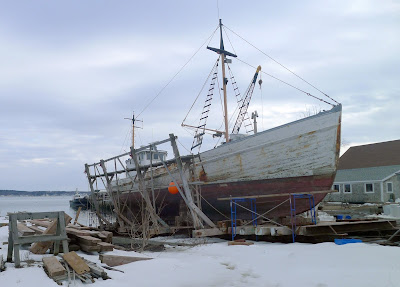What should you think about when setting up to paint? Tide, time of day, and the light are key, but there are other factors as well.
 |
| Ladona, (unfinished) by Carol L. Douglas |
We’ve had so many dark, gloomy days recently that I was startled awake at the first gloaming. By 6 AM the sun was streaming through my bedroom windows, warming the air, promising great things.
My plan was to paint Ladona in drydock. She is the former Nathaniel Bowditch, completely rebuilt for the 2016 season. Her owners also operate the Stephen Taber, which I painted in Pulpit Harbor last summer.
 |
| Stephen Taber raising her sails, by Carol L. Douglas |
Unlike most of the schooners in mid-coast Maine, Ladona was built as a private yacht, in Boothbay Harbor in 1922. She has the sleek, lean lines of a pleasure boat. After a brief stint as a patrol boat in New York Harbor during World War II, she was used for commercial fishing. In 1971, she was rebuilt as a commercial schooner.
| Power-washing made a world of difference. |
I know the North End Shipyard well. Yesterday, I thought, would be an excellent opportunity to make a short video talking about where to set up for a plein air painting. On the coast of Maine, we have to consider:
- · Tide
- · Time of day
- · Angle of sun
- · Ergonomics
- · Courtesy
- · Transience.
The Gulf of Maine has the largest tidal range on the planet. In the Bay of Fundy the tidal range is a staggering 50 feet. Here in Maine, the difference is only about half that, but that’s still imposing, considering that the average tide in most places is just a few feet.
| I wasn’t the only person painting in the rain. |
The best solution is to work from a floating dock, which keeps you on the same plane as your subject. When that’s not possible, you can break up your picture over several days.
If you don’t own a compass, invest in one (or an app on your phone). You need to know where the sun is headed. That changes with the seasons. In the winter, the sun never makes it to the top of the sky, which means the light stays golden. In the summer, the light is clearer and cooler.
Many of the places we find quaint and picturesque are actually people’s workshops. As a matter of courtesy, never go on private property without asking. Stay out of the way of heavy equipment and trucks. For your own comfort, bring earplugs if there are air compressors or other equipment nearby. And avoid traps for yourself, like a painting location exposed to a brutal wind or the harsh sun.
 |
| A smarter person would have gotten this canvas under cover before it got wet. Once this happens, you have to let the painting dry naturally. |
A deep understanding of the subject doesn’t just inform your paintings; it sets your schedule. I am concentrating on the boats in the cradle right now, because they’re transient. I can paint the sheds, the lobster boats, or the boats at anchor all summer.
Wooden boats require a lot of wood to keep them healthy, and that material is always stacked around the boatyard in interesting ways. (It’s also heavy, as Captain Noah Barnes noted as he dropped a timber onto a workbench with a resounding clatter.)
I wanted to focus on the foreground detritus of lumber, tools, and equipment. I experimented with a number of cute compositions, but Ladona resolutely refused to be cropped.
The sky grew steadily cloudier as the afternoon progressed. “It’s not going to rain until after 5,” Captain Doug Lee told me. That may be what the National Weather Service said, but the Maine coast is unpredictable. A quick shower around 3 PM washed me out.
Once the canvas has water droplets on it, your best bet is to let the surface dry naturally. Luckily, I live just down the road, so it’s no big deal. I’ll go back this morning and put the rigging in.


